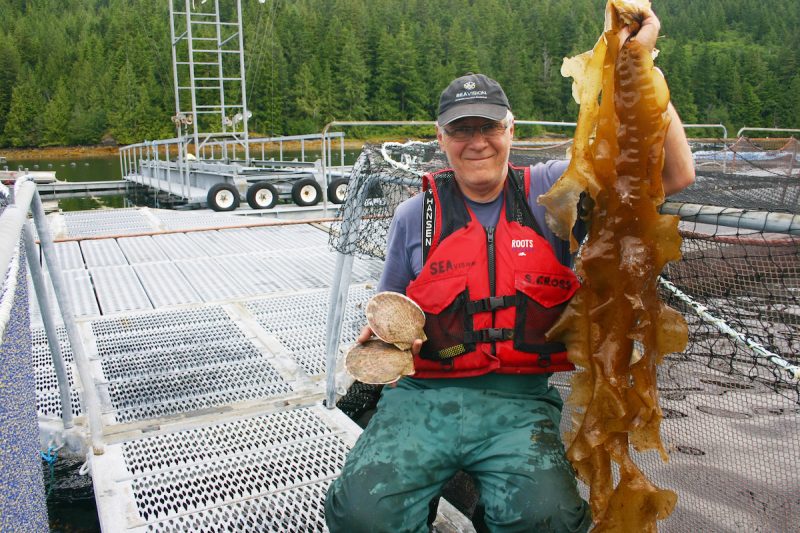Seaweed sleuth offers a ‘kelp-ing’ hand for B.C.’s coastal communities
Cascadia Seaweed aims to become the largest producer of seaweed in the Pacific Northwest
By Fabian Dawson
SeaWestNews
For many, seaweed is perceived as little more than slimy marine debris on the beach.
For Dr. Stephen Cross that slimy debris holds a treasure trove of opportunities to mitigate climate change, and combat ocean acidification while providing new economic pathways for B.C.’s coastal communities.
There is huge environmental and economic potential in seaweed farming because British Columbia has the world’s most diverse seaweed species, said Dr. Cross, the former Industrial Research Chair for Sustainable Aquaculture at North Island College (NIC) in B.C.
The seaweed sleuth said there are more that 630 seaweed species in B.C.’s 20,000 km of coastline, making it conducive for “incredible production and market opportunity”.
At the moment, seaweed harvest in the province is mostly from the wild, totalling roughly 800 to 1,000 MT per year.
But this number could rise dramatically if Dr. Cross has his way.
Together with three others, he has formed Cascadia Seaweed to become the largest producer of seaweed in the Pacific Northwest.
“We will do this by partnering with First Nations and coastal communities to seed, grow, harvest, process and sell products to a market in high demand for sustainable protein,” said Dr. Cross.
Based out of Sidney, B.C, Cascadia Seaweed states it chooses potential farming sites “with the utmost respect to the environment and the peoples that have been on the land and water before us,”.
One such site is in Useless Inlet off Vancouver Island. This is the future home to a seaweed farm in partnership with a local First Nations company, Nuu-chah-nulth Seafoods LP.
Cascadia’s process of commercially farming seaweed involves attaching seedlings onto a rope that is strung between two vertical lines drawn taught by an anchor and a float. The rope is deployed into open ocean where the seaweed grows until it attains a size ready for harvest. The seaweed laden rope is brought onto a boat where the plant is cut from the rope, delivered to shore, processed and sold into the domestic or international market.
Dr. Cross said while the potential for seaweed in the cosmetic, pharmaceutical and food sectors are growing, seaweed can also play an important role for B.C.’s salmon farmers.
He recently completed a study with the B.C. Salmon Farmers Association (BCSFA).
“The kelp-growing study involving over 40 fish farms showed good potential in growing seaweed within salmon farm tenures,” said Dr. Cross.
Kelp, which is part of the seaweed family, is now considered a superfood—rich in iodine and several vitamins—and demand is soaring.
The study with BCSFA members, Creative Salmon Company, Marine Harvest Canada (Mowi)
Grieg Seafood British Columbia and Mainstream Canada found that excess nutrients from a fish farm could act as a fertilizer for kelp, supercharging the plant’s growth. In addition to kelp providing additional revenue, it will also absorb much of a farm’s waste, and act as a carbon sink.
B.C.’s potential for seaweed cultivation was also bolstered by a recent study by researchers at University of California Santa Barbara, who investigated the carbon offsetting potential of seaweed aquaculture.
“It’s not a silver bullet, nor an industry that exists yet,” said Halley Froehlich, an assistant professor in the Department of Environmental Studies and in the Department of Ecology, Evolution and Marine Biology.
“But it has huge potential,” she said.
Froehlich is lead author of the first-ever global assessment of seaweed aquaculture’s carbon sequestration scaling potential, which appears in Current Biology.
According to the study, 48 million square kilometers of the oceans are suitable for seaweed aquaculture, which could help carbon offsetting by sinking the algae that stores carbon in its tissues in the deeper ocean.
There is substantial suitable area in which seaweed could be farmed, and a relatively small proportion (0.001%) would be enough to render the entire global aquaculture industry carbon neutral, according to the study
Relative to the rest of the world, seaweed aquaculture in North America is still somewhat in its infancy.
“The vast majority of seaweed aquaculture occurs in Southeast Asia,” Froehlich said, adding
seaweed farming has other appealing and beneficial environmental effects,
“We like to call it ‘charismatic carbon’ because it has additional benefits…such as potentially providing habitat for fish and other marine life, reducing ocean acidification and oxygen depletion, and taking up excess nutrients in local areas.” (Image of Dr Stephen Cross courtesy of NIC)

